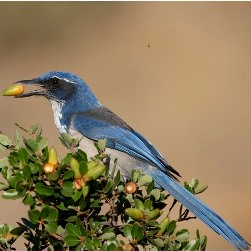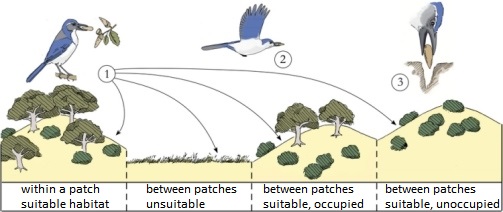Mutualism with food-storing birds helps tree populations on the move
LINKED PAPER
Scatter-hoarding corvids as seed dispersers for oaks and pines: a review of a widely distributed mutualism and its utility to habitat restoration. Pesendorfer, M.B., Sillett, T.S., Koenig, W.D. & Morrison, S.A. 2016. The Condor: Ornithological Applications. DOI: 10.1650/CONDOR-15-125.1 View
Birds in the family Corvidae – crows, jays, magpies, and nutcrackers – often store food in caches scattered throughout the landscape. “Scatter-hoarding” provides the birds access to food in times of need, and becomes seed dispersal when a bird fails to retrieve all its cached seeds. This seed dispersal mutualism enables large-seeded trees throughout the Northern Hemisphere to expand their populations and colonize new habitat, particularly in the face of rapid climate change. Conservation managers can therefore take advantage of scatter-hoarding behavior by manipulating the birds into helping restore tree populations.
Corvids have received a lot of attention for the cognitive abilities associated with food-hoarding, but their ecological role is often viewed less favorably. In fact, hundreds of thousands of crows and jays are shot each year, both in Europe and North America, mainly under the assumption that they depredate populations of songbirds and small game mammals. A recent review article in IBIS, however, found the extent of their role as songbird nest predators to be much smaller than assumed (Madden, Arroyo & Amar, 2015). Conversely, our broad survey of the literature found that the birds’ unique food storing behavior benefits tree populations.
Inspired by our research on island scrub-jays (Aphelocoma insularis), medium-sized corvids that are endemic to California’s Santa Cruz Island, we surveyed the scientific literature for other examples of this seed dispersal mutualism. The goal of the effort, conducted in collaboration with my colleagues at the Cornell Lab of Ornithology, the Smithsonian Migratory Bird Center, and The Nature Conservancy, was to determine the geographic extent of this type of mutualism, to identify general patterns across species, and to investigate its utility for habitat restoration efforts.
Figure 1 The process of scatter-hoarding involves three distinct phases, each with their own impact on plant fitness: seed selection, transportation, and deposition.
Illustration © Emily Underwood
Seed selection: Corvids are quite picky; they avoid seeds that are spoiled by fungi or infested with insect larvae. Large proportions of pine or oak seed crops can be infested while still on the tree, but the birds mainly transport viable seeds away. Their selectivity thus increases the quality of the dispersed seeds relative to the available crop on the trees.
Seed transportation: Several aspects of seed transportation during scatter-hoarding affect the quality of seed dispersal. In contrast to ingested seeds, for example, the treatment during the transport does not damage the seeds in any way. The birds may place a few seeds in their throat and hold one with their bill. Some species, such as the nutcrackers (Nucifraga spp.), even possess pouches below their bill that facilitate the transport of unharmed seeds.
The distance over which corvids transport seeds also sets them apart from other scatter-hoarders. Clark’s nutcrackers (N. Columbiana), for example, transport seeds of mutualistic whitebark pines (Pinus albicaulis) up to 30 kilometers across the landscape of the Rocky Mountains before caching them. While such dispersal distances represent an extreme, we found that wherever scientists studied the ecological role of corvids, the birds were the dominant long-distance dispersers for large-seeded plants.
Plants reap another benefit from their winged dispersal mutualists in fragmented landscapes. Most scatter-hoarding rodents avoid crossing open areas, but jays and crows navigate mosaics of habitat types with ease. Dispersal between various patches of suitable habitat increases in importance as natural habitats become fragmented. Because the birds often show strong habitat preferences – they like to hide seeds at the edge of brush, or in recently burned areas – their scatter-hoarding can result in directed dispersal, the disproportional placement of seeds in areas that are suitable for germination and seedling establishment.
Seed deposition: The final step of the scatter-hoarding process helps seeds to avoid predation. When the birds have chosen a location for their cache, they place the seed several centimeters deep into soil, leaf litter, or cracks in the ground, and use surrounding materials to disguise it from potential thieves. For seeds that are not retrieved by the bird, such locations also favor germination and seedling establishment.
Figure 2 Geographic extent of the seed dispersal mutualism between pines, oaks, and corvids. Global distribution of the oak genus Quercus and of wind-dispersed Pinus species, as well as of corvid genera the dominantly scatter-hoard seeds.
Illustration © Emily Underwood.
A surprising finding of our study was how widespread the corvid – tree mutualism is throughout the Northern Hemisphere. Drawing on case studies from Europe and North America, we identified several conservation applications for managers of oak and pine restoration projects. In Germany, land managers provide jays with large buckets of acorns, encouraging them to hoard more seeds than necessary, and inadvertently establish oak seedlings. The creation of “caching target zones” by establishing brushy habitat islands may can direct the birds’ efforts to managed areas. Finally, in places where the dispersal mutualism has been interrupted because corvids have disappeared, assisted migration of the birds may re-establish this crucial ecosystem function.
In summary, our study shows that scatter-hoarding of seeds by corvids results in mutualistic interactions with trees. We identified a number of aspects of the birds’ behavior that provide fitness benefits for the plants, and were surprised by the large geographic extent of this mutualism. As tree populations face a number of challenges from climate change and habitat fragmentation, incessant hoarding of seeds by corvids is likely to play an important role in facilitating tree dispersal and ecosystem recovery.
References
Madden, C.F., Arroyo, B. & Amar, A. 2015. A review of the impacts of corvids on bird productivity and abundance. IBIS 157: 1-16. View
Image credit
Featured image: Island scrub-jay Aphelocoma insularis © Colin Woolley
If you want to write about your research in #theBOUblog, then please see here.






